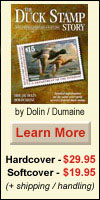 |
10% off on
web orders over $100 |
|
|

|
|
Scott increases many duck stamp values
Early plate blocks show dramatic jumps
by Bob Dumaine
The Scott 2002 Specialized Catalogue for United States has hit the shelves of stamp stores and suppliers. Each year I feel it appropriate to review the values changes of the state and federal duck stamp section to give readers an idea of the marketplace.
All values stated are for very fine stamps, and in the mint category, also never hinged. To begin, an overview of the value for an entire set of signed stamps, RW1-68 remained about even with last year at $1,310. A mint never hinged single set jumped a bit from $5,886 in 2001 to $6,096 for 2002. A set of plate blocks continued their upward trek and rose from $51,870 to $55,637. Nice increases overall, with the hot stamps showing higher values.
The major increases in the plate blocks were for RW1, raised $1,000 to $12,500, and RW2 with a healthy jump from $8,750 to $10,000. RW3 through RW9 also posted modest gains, as did RW17 through RW26
For mint singles, the RW5, a much-sought after issue, jumped from $350 to $400, with RW6 and RW9 each moving up $25 to $225. RW26, the black lab stamp, jumped up $5 to $100, and continues to be in high demand.
Modern ducks show some increases
The modern $15 ducks that are off-sale after three years from the philatelic agency, moved up to $24 from $22.50. However, the increases in this area RW58-63 were bumpy and inconsistent. For example, the first $15 face value duck, RW58, remained unchanged, as did RW60, but RW59 increased, as did RW61 through RW63 to $24 each.
My experience is that all the $15 issues are equally difficult, and should share the same value of $24 from RW58 through RW65. Collectors and dealers simply did not put back quantities of these issues due to the high face value.
In time, I believe we can expect the gummed issues from RW65 and forward to show their scarcity compared to the PSA type stamps, which began with the RW65 issue and co-exist with the gummed versions. The reason remains very straightforward; the gummed stamps were generally not made available to post offices, other than philatelic windows of larger cities, if then.
A collector wandering into a post office to buy a duck stamp was stuck with the PSA version, and we've had reports many clerks were not aware the gummed versions still existed.
The Washington eagle-eyed bureaucrats have conducted “studies” that show a sharp decrease in gummed stamp sales, and therefore proclaim them unpopular. The fact is collectors prefer the traditional gummed stamps, which are also significantly less expensive to produce.
The PSA was created to increase convenience to retail outlets such as K-Mart, Target, Wal Mart, along with sporting goods stores and other outlets. The PSA stamp is the size of a dollar bill, comes with a UPC code for price, and fits snugly into a cash drawer, a much more convenient system than a pile of gummed stamps jumping out of cash register drawers.
Many state ducks remain undervalued
State waterfowl stamp values bounced around, with some issues gaining, some losing, but most remaining stable. One of the most notable under-catalogued states is Wyoming; with many of the 1984-91 values below dealers buy prices. Remember, except for 1985, these years were not included in the original Scott State and Federal Duck Stamp Album, so after going off sale, many dealers and collectors found their inventories quickly exhausted of these stamps.
State stamps remain an enigma regarding their value. Some stamps are nearly impossible to find, but have low catalog values. Others are higher valued, but most dealers have ample inventories. One example of an undervalued item is UT9, their 1994 issue featuring a mallard and Chesapeake Bay retriever. The “new” 2002 value is listed at $12 for a mint single, but most dealers sell them for $50-75.
Some of these variations are due to timing of the input from Scott’s value editors, and publication of the catalogue. In this case, the stamp print was immensely popular with collectors, demand shot up, and the “loose” stamps were suddenly absorbed from the market.
In other cases, quantities of state stamps have been discovered, having a negative impact on values. One spectacular case involved Michigan #1, the 1976 issue. In 1990, dealers were asking $35 per mint stamp; however, a huge quantity found in a dumpster in Michigan surfaced, dropping the value to it’s current $5.
Basically, state duck collecting is still in its infancy compared to postage stamps. Similarly, the values have risen, fallen, risen again, and many remain in volatile state. Eventually, some issues prove to be very scarce, and others become very abundant. The collecting public is often fickle, with dealers and speculators following their lead.
During the early 1990s down phase of pictorial state duck stamps, many collections were sold, and dealer inventory purchases of new issues cut back. The result today, is a true stamp shortage for those states that took their stamps off-sale within a year or two after issue.
If someone wants to gain some quick knowledge of the developing scarce issues, check the buying lists of various dealers. Their lists will generally tell you volumes about which issues are future winners. |
 Back | News Page
Back | News Page
|



















